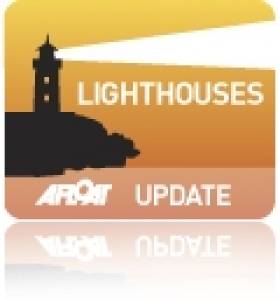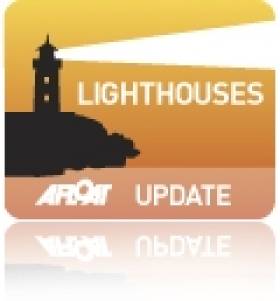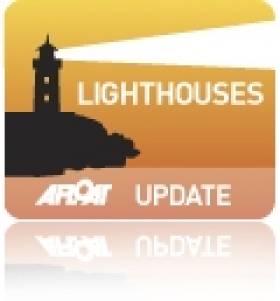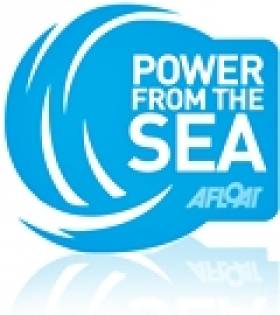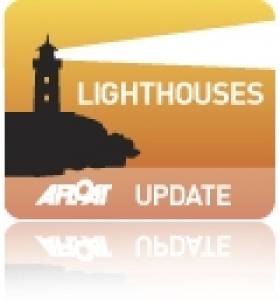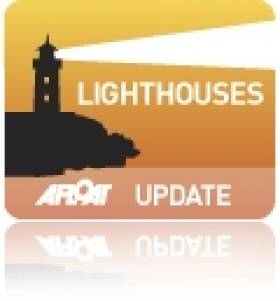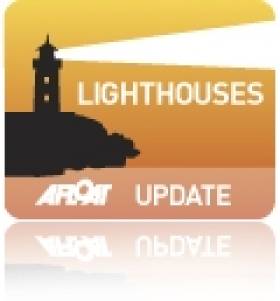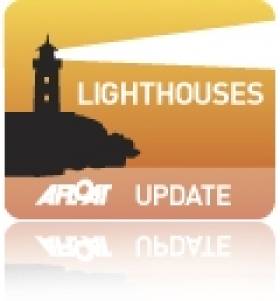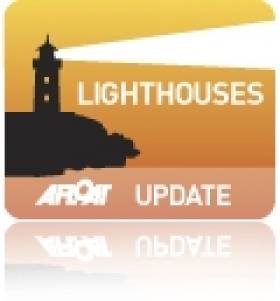Displaying items by tag: CIL
Irish Lights Ready for Marine Emergencies, Helicopter EC135 Available for Offshore Stations
#lighthouses – As we face into a period of stormy weather over the Christmas period Commissioners of Irish Lights (CIL) stands ready to respond to any marine emergency in Irish Waters. CIL is responsible for the maintenance of physical and electronic Aids to Navigation around the Irish Coast and for ensuring safe navigation of passenger and cargo traffic in the event of wreck or other new dangers.
CIL has provided AtoN services in Ireland for over 200 years. The time of the lightkeeper has now passed as automation came to the fore in 1996 but guiding those at sea home safely during Christmas is essential in CIL's service to the mariner.
Irish and UK AtoN are monitored 24 hours a day via a sophisticated network of remote coastal communications links. This ensures that Ireland's coastal navigation network of 72 lighthouses, 29 beacons, and 118 buoys meets the international availability standard of 99.8%, giving all mariners a high degree of confidence and security for passage planning.
In the case of emergency in Irish waters, the Granuaile, CIL's 80 metre multifunctional ship with her highly experienced captain and crew of 15 will respond immediately. CIL's mechanical, electrical and electronic experts are on call 24 hours a day to cover any emergency. Lighthouse attendants around Ireland are also ready to deliver local response when required. A pilot and EC135 aircraft from Irish Helicopters is also on standby in case of emergency at offshore stations.
Modern technology now assists with the immediate response to any incident at sea. Virtual AtoNs can be digitally placed in areas of new danger through the Automatic Identification System (AIS) which all larger vessels are now required to use. As 95% of all goods arrive in Ireland by sea CIL's service and provision of maintaining AtoNs around the Irish Coast ensures the safety and efficiency of this vital service over the holiday period.CIL is a modern Maritime Safety Organisation whose mission is to 'provide aids to navigation and allied services for the safety of persons and infrastructure at sea, while also helping protect the marine environment and supporting the marine industry and coastal communities'. While CIL can date its establishment to a 1786 Act of Parliament, the organisation has always prided itself in its innovative and efficient service delivery. Today, the organisation remains committed to the efficient, effective sustainable delivery of services as it exploits new technology and new commercial opportunities.
CIL is based in Dun Laoghaire, Co. Dublin. CIL are responsible for providing marine aids to navigation (AtoN) under the Safety of Life at Sea (SOLAS) convention.
• CIL provide and maintain over 300 general aids to navigation
• CIL manage 4,000 local aids to navigation
• CIL mark or remove dangerous wrecks outside harbour areas around Ireland
CIL AtoN include radio aids such as Differential GPS (DGPS), Radar Beacons (Racon), and Automatic Identification Systems (AIS), as well as traditional visual aids such as lighthouses, buoys and beacons. These AtoN complement Global Navigation Satellite Systems (GNSS), such as GPS, which are the primary means of navigation for most mariners. If satellites are not available, these AtoN provide position, spatial awareness, hazard marking and backup.
Please visit www.cil.ie for further information.
Modification Work for Irish Lights Aids to Navigation Vessel
#LighthouseTender – The Commissioners of Irish Lights ILV Granuaile (2000/2,625grt) an aids to navigation tender vessel, is undergoing steel modification works while berthed in Dublin Port, writes Jehan Ashmore.
Work on the 79m long tender which is moored at Sir John Rogersons' Quay close to the East-Link Bridge, is been carried out by Arklow Marine Services.
The work involves fabricating of a new radar mast, installation of calorifier units and modifications to the bridge.
Steel work modifications entail fitting under deck strengthening in way of ROV pads which are to be in accordance and to the approval of Lloyds.
Killybeg based Barry Electronics are supplying and fitting a new radar which requires a new mast with existing steelwork and platform being removed.
The new calorifier unit which is to replace existing plant will be piped in using 316 stainless steel pipe materials. It is expected the quayside work be completed by the middle of this month.
ILV Granuaile is the third tender to carry the name of the famous Mayo pirate Queen.
She was built by the Damen Shipyards Group, where the hull and superstructure were completed in Romania in Galati, the largest port town on the River Danube.
Following launching, she was towed through the Black Sea to the Netherlands for fitting out at another Damen shipyard, where work included the installation of electronic equipment.
Cork Dockyard Carries Out Docking Survey of Lighthouse Tender
#DOCKING SURVEY– The Commissioners of Irish Lights aids to navigation tender ILV Granuaile (2000/2,625grt) is currently at Cork Dockyard Ltd undergoing her scheduled docking survey, writes Jehan Ashmore.
The tender built in Romania over a decade ago and fitted out in the Netherlands by the Damen Shipyard Group, is required under regulation to drydock twice in five-yearly cycles. Her last docking was in 2009 and the the bouy-laying vessel is due her next scheduled docking in 2014.
Such docking is required by Classification Societies to inspect the underwater areas including hull, propellers, rudders, engine cooling systems, anchors, cables and anti corrosion systems.
At the same time the opportunity is taken to remove marine growth and to apply antifouling paint coatings to the underwater areas and to prepare and paint the ships hull. The principle dimensions of the hull are 79m long on a beam of 15m and with a shallow draft of 4.4m.
She has accommodation for an extra 10 persons or can accept modular housing on the after-deck where navigational aids (bouys) are stowed in cradles. Heavy lifting equipment including a 20 tonne crane with an outreach of 20m is used to position the bouys at pinpoint accuracy using satellite technology. There are 150 offshore buoys which warn mariners of the location of sand banks, reefs, and other offshore hazards near shipping routes.
A helicopter landing deck over the bow is used to transfer maintenance personnel and equipment to certain lighthouses.
ILV Granuaile's homeport is Dun Loaghaire Harbour, where she is seen frequently loading and unloading buoys alongside the various piers. On occasions she enters through the marina to berth alongside the Commissioners headquarters which includes a marine workshop depot facility, though this can only be done on certain tides and for a short duration.
Asides her primary duties serving the lighthouse authority, the vessel is capable of carrying out chain work, search and rescue, salvage and recovery, oil pollution control, towing, hydrographic applications, and ROV work.
Buoy Takes Front Seat Row at Ocean Energy Conference
#OCEAN ENERGY – As previously reported the fourth International Conference on Ocean Energy (ICOE) which concludes tomorrow at the Convention Centre Dublin, is where an Irish Lights buoy has been deployed facing the venue's prime river frontage, writes Jehan Ashmore.
After previous ICOE conferences held in Brest and Bilbao, Sustainable Energy Authority of Ireland (SEAI) and partners European Ocean Energy Association's (EU-OEA) have brought the internationally important conference to the Irish capital. A notable feature to mark the three-day conference is the buoy, which is a Type 2 Port Laternal Marker, only one of two such buoys within the inventory of the Commissioners of Irish Lights.
It is fitted with a variety of meteorological and oceanographic sensors which will be tweeting data automatically via the automatic identification system (AIS), giving a unique insight into weather conditions outside the convention centre.
Former Irish Lights Headquarters for Sale
#PROPERTY HQ– The Irish Times reports that the Dublin based former headquarters of the Commissioners for Irish Lights are to be offered for sale at €2.85 million on the instructions of Nama – a 89 per cent per cent drop on the €26 million paid for the block in 2006 by Pembroke Partnership.
Wesley Rothwell of CBRE says the building, (located on 16-19 Pembroke Street in Dublin 2), has not been occupied since it was sold, is now in need of extensive refurbishment.
The property became redundant when the Commissioners relocated in 2008 to a brand new custom-built HQ on the waterfront within Dun Laoghaire Harbour. As previously reported on Afloat.ie, the distinctive landmark building is to be open to the public next Sunday as part of the Open House Dublin Weekend.
Irish Lights Headquarters to Open to the Public
#OPEN HOUSE- The Commissioners of Irish Lights headquarters in Dun Laoghaire Harbour is to be made open to the public with tours on Sunday (7 October) as part of the annual Open House Weekend, writes Jehan Ashmore.
The iconic landmark building which incoporates innovative technological features is located on the waterfront within the harbour, and in which integrates seamlessly into its marine environment. The Commissioners are a General Lighthouse Authority (GLA) that is responsible for all aids to navigation around the coast of Ireland.
To enable the authority to carry out these functions, the building has an administration block and adjoining marine workshop depot. Adjacent to the facility is a berth where the ILV Granuaile (2000/2,625grt) can moor alongside to load and unload these aids to navigation. The tours will provide a fascinating insight into the work of the commissioners.
For further details and how to book a tour, plus a list of other buildings available to access and more click this LINK.
Open House Dublin is an initiative of The Irish Architecture Foundation which has an established network and track record in delivering major projects primarily aimed at developing audiences for architecture in Ireland. The foundation is also involved in raising the profile of Irish architecture abroad.
#NEW IRISH LIGHTHOUSE – The first lighthouse of a new generation to dot the Irish coastline was officially 'switched-on' at Roancarrigmore, a small island marking the eastern entrance to Castletownbere Co. Cork, writes Jehan Ashmore.
The ceremony was performed by Minister for Agriculture, Food and Marine, Simon Coveney, T.D. Constructed of stainless steel the new structure stands only 8.5m high and is sited at the foot of the original lighthouse that towers above, where there has a light since 1847 to warn shipping to the dangers of the rocky island.
The Commissioners of Irish Lights have taken an international lead in developing this new state of the art lighthouse, which beyond technical advances is also geared to make significant cost savings due to very low maintenance requirements.
In addition there will be environment benefits from the replacement of diesel generation by renewable energy and the ending of waste-water and refuse disposal.
The lighthouse has a low-voltage LED Light and provides a clearer quality of light and is far more reliable than traditional filament lamps. The new lighting system is powered using 12 x 50W solar panels to replace the masonry tower which had a 100 Volt, 1,500 Watt filament lamp and diesel generators.
The sectored light will be supplemented and monitored by Automatic Identification System (AIS) functionality which advises the mariner directly on their bridge of the status and position of the light.
AIS is a key component of the International Maritime Organisation e-Navigation project and will ensure Roancarrig is equipped to take advantage of this initiative.
In addition there are proposals to examine possible new uses for the older lighthouse which is adjoined by a former lighthouse-house keeper dwelling used by previous generations before automation took over.
Arklow Newbuild’s Link to Former Irish Lights Tender
#FORMER IRISH LIGHTS TENDER -With the Guardian 8 preparing to set sail from her builders homeport of Arklow this month, as previously reported on Afloat.ie, her owners Gardline Marine Services also operate a former Commissioners of Irish Lights tender, writes Jehan Ashmore.
The Great Yarmouth based company operate a multi-purpose fleet which includes the survey vessel Ocean Seeker (PHOTO). She was a familiar sight as the ILV Granuaile (1970/1,943grt) while serving for three decades from the Irish Lights marine depot in Dun Laoghaire Harbour.
Built by Fergusan Brothers of Port Glasgow, she was the last traditional tender for CIL in that her working deck was positioned forward. Apart from the short career of the Gray Seal, the 2000 built successor ILV Granuaile (the third to carry the name of the Mayo pirate queen) was the first custom built tender for CIL to introduce a radical design with an aft end work deck.
Open House Dublin: Public Tours of Irish Lights Headquarters
Regular guided tours will provide a fascinating insight into the work of the Commissioners of Irish Lights (CIL). The tours (first-come basis) are also available for disabled access and they start from 12 noon to 5pm, noting the last tour is 4.30pm. Location: Harbour Road, Dún Laoghaire.
Like most of the tours and events in Open House Dublin, there is no pre-booking required. Entry is FREE and on a first-come basis. For more information about what to expect from your tour or event, check the How It Works by clicking HERE.
CIL operate the 79m aids-to-navigation tender ILV Granuaile which is based at her homeport of Dun Laoghaire. The 2,625grt tender was built by the Dutch Damen Shipyard group in Galati, Romania. She was then towed to The Netherlands where further outfitting work was conducted. She entered service in 2000 and she is the third tender to be named after the Mayo pirate queen.
Occasionally ILV Granuaile can be seen moored alongside the berth adjacant to the marine depot accessed through Dun Laoghaire Marina, though she mostly calls to the harbour's western bight area, using her DP (dynamic-positioning) mode. Her design is ideally suited for buoy and chain work, search and rescue, salvage and recovery, towing, hydrographic applications, and ROV work.
She is shallow drafted at 4.4m and has heavy lifting equipment including a 20 tonne aft-mounted crane with an outreach of 20m. Accommodation is for a crew of 16 in addition there are cabins for a further 10 persons.
Irish Lights Appoint New Chief Executive
For the last 19 years Ms Shields has worked in the marine sector, most recently as Director of Strategic Planning and Development at the Marine Institute since 2004. In this role she had responsibility for oversight and management of the National Marine Research Programme, EU and International Policy and Programmes, Ocean Energy, Marine Technology and the Marine Data and Information Services Group of the Marine Institute.
Prior to this she held the position of Director of Science and Technology at the Marine Institute with responsibility for Research Vessel Operations, the National Seabed Survey, Oceanographic Services and the National Data Buoy Network. In addition she has worked in the marine tourism, aquaculture and private-forestry sectors.
- Ocean Energy
- Marine Institute
- Commissioners of Irish Lights
- Irish Lights
- Dun Laoghaire Harbour
- Yvonne Shields
- CIL
- Dun Laoghaire Harbour News
- National Marine Research Programme
- Marine Data and Information Services Group
- Director of Science and Technology at Marine Institute
- Marine Insitute Research Vessel Operations


























